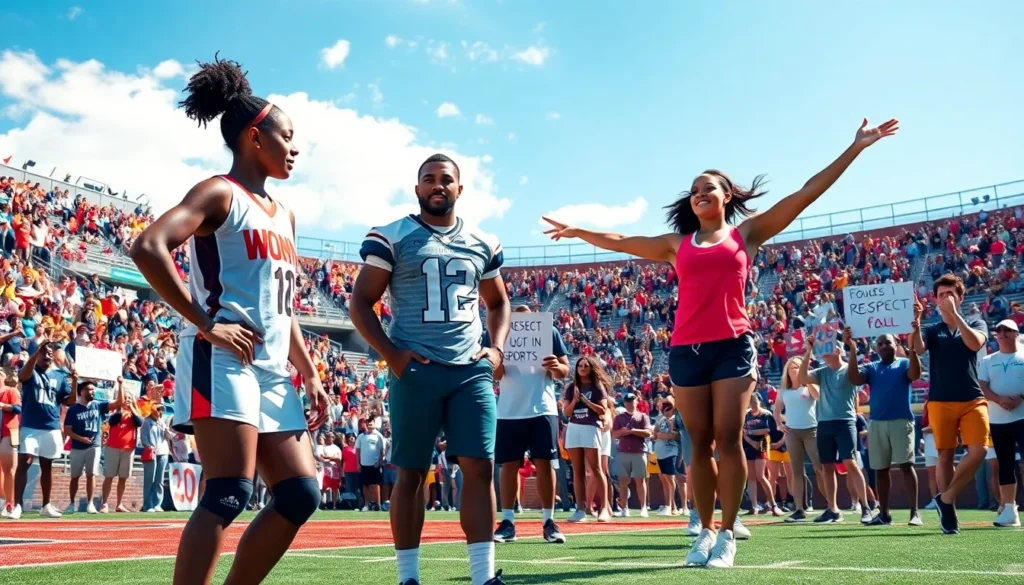Table of Contents
ToggleIn today’s dynamic landscape, sports are far more than just games played on a field. They have become a crucial reflection of society, embodying cultural shifts, technological advancements, and social movements. This article delves into the intersection of sports and society, exploring how various factors shape the sports narrative, the evolution of fan engagement, and the promising future of athletics.
Understanding The Intersection Of Sports And Society

Sports often serve as a microcosm of society, reflecting its values, issues, and transitions. Throughout history, sports have played a significant role in cultural identity and social integration. In many communities, sports serve as a platform for dialogue on pressing societal issues such as race, gender, and mental health. For instance, the founding of leagues like the Women’s National Basketball Association (WNBA) not only provided visibility for female athletes but also sparked conversations about gender equality in sports. Similarly, athletes such as Colin Kaepernick have leveraged their platforms to raise awareness on systemic racism and police brutality, showcasing how sports can catalyze social change.
This intersection provides a unique lens for understanding public sentiment, as sports figures often become symbols of wider societal movements. As sports continue to evolve, so too does their role within society, affecting attitudes and inciting action.
The Role Of Media In Shaping Sports Narratives
Media coverage has drastically transformed the sports landscape, influencing how narratives are formed and perceived. Traditional media, such as television broadcasts and newspapers, used to hold a dominant position, but the rise of digital platforms has democratized sports coverage, allowing for diverse voices to emerge. Social media platforms like Twitter, Instagram, and TikTok have become pivotal in shaping narratives, offering fans immediate access to highlights, behind-the-scenes content, and athlete interactions.
The way stories are told can have a profound impact on public perception. For example, athletes who share personal challenges and triumphs, such as Naomi Osaka discussing mental health, humanize their experiences, allowing fans to connect on a deeper level. Besides, media’s ability to amplify certain voices leads to broader discussions about representation and diversity in sports. Brands are also leveraging these narratives to connect with audiences more intimately, offering authentic stories that resonate with fans.
Emerging Trends In Sports Technology
As technology continues to evolve, it relentlessly shapes the future of sports. Cutting-edge advancements, from wearable fitness trackers to augmented reality (AR) and virtual reality (VR), are redefining how athletes train and how fans engage with the sports. Wearable technology not only provides real-time health data for athletes but also enhances performance analysis, enabling teams to make data-driven decisions.
Also, AR and VR create immersive experiences for fans, allowing them to feel as though they are part of the action from the comfort of their homes. Major sporting events are incorporating these technologies, granting fans unique views of games or letting them experience the thrill of being on the field. With developments like blockchain technology enhancing ticketing and merchandise, the intersection of sports and technology thrives, offering unprecedented opportunities for innovation and engagement.
Fan Engagement: The Evolution Of Sports Communities
Fan engagement has transformed drastically in recent years, evolving from passive viewership to active community participation. Sports teams are now leveraging online platforms to foster community spirit, encouraging fans to engage not only in watching games but also in discussions and activities that revolve around their favorite teams.
Social media channels play a crucial role in this transformation: fan forums and interactive polling on platforms like Instagram or Twitter allow fans to voice their opinions and connect with others who share similar passions. Besides, tailored content that resonates with fan interests enhances loyalty, making them more than just spectators but active participants. Teams are also introducing loyalty programs and exclusive content, such as behind-the-scenes videos and player interviews, to deepen their connection with fans, creating a rich tapestry of community and engagement.
Social Justice Movements Within Sports
The intersection of sports and social justice has gained increasing attention, particularly in recent years. Athletes’ voices are being amplified in advocating for social change, encouraging fans and their communities to take action. Movements such as Black Lives Matter have found allies in numerous athletes who leverage their platforms to demand justice and equality.
The NBA’s response to calls for social justice during the 2020 season is a prime example of how sports can lead societal discourse. Teams and players utilized their platforms to raise awareness, showing solidarity through symbolic actions such as kneeling during the national anthem. These movements not only spotlight injustice but also foster community engagement and activism, reminding society that athletes are not just entertainers but also influential advocates for change.
The Future Of Sports: Predictions And Innovations
Looking ahead, the future of sports appears to be teeming with innovations that promise to change the landscape forever. As technology continues to advance, forecasted trends indicate a greater integration of AI and big data in decision-making processes, from coaching strategies to player health. Also, the rise of eSports is shifting how fans engage, offering a younger generation a new medium through which to express their passion for gaming and competition.
Also, sustainability is likely to become a major focus in sports. Initiatives aimed at reducing the carbon footprint of events and teams are becoming increasingly mainstream, prompted by a collective consciousness about climate change. Future sports venues may carry out eco-friendly designs and renewable energy sources, ensuring that sports play a pivotal role in contemporary environmental conversations.
Conclusion
The intersection of sports and society is complex and dynamic, evolving alongside cultural shifts, technological advancements, and social movements. Through media narratives, technological innovations, and active fan engagement, sports are positioned as a powerful vehicle for change and connection. As society continues to grapple with critical issues, the role of sports as a platform for dialogue and activism will only grow. The future of sports looks promising, with countless possibilities for innovation and transformation, making it an exciting space to watch.







